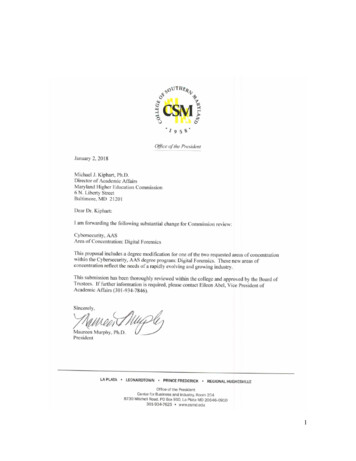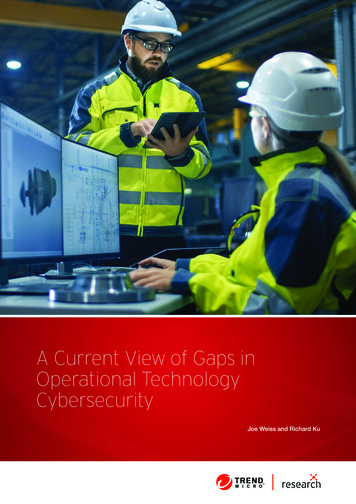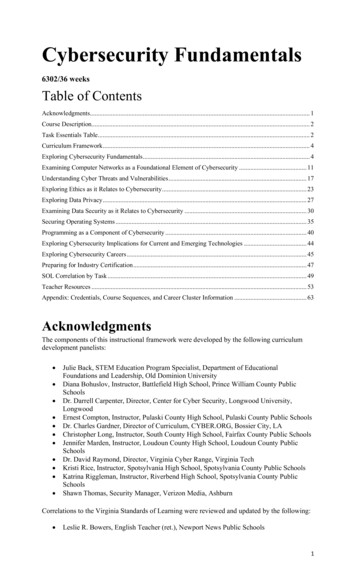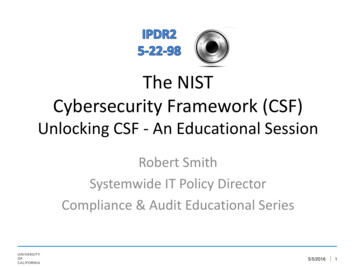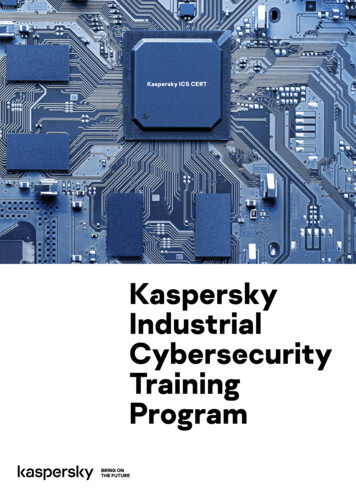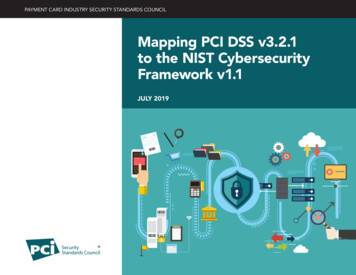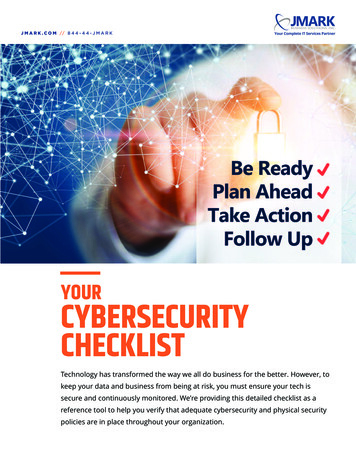
Transcription
J M A R K . C O M // 8 4 4 - 4 4 - J M A R KYOURCYBERSECURITYCHECKLISTTechnology has transformed the way we all do business for the better. However, tokeep your data and business from being at risk, you must ensure your tech issecure and continuously monitored. We’re providing this detailed checklist as areference tool to help you verify that adequate cybersecurity and physical securitypolicies are in place throughout your organization.
CYBERSECURITY CHECKLIST2JMARK.COMCybersecurity is defined as a system of technologies, processes, and practices designedto protect your computers, networks, applications, and data from attack, damage, orunauthorized access.IDENTIFICATION PROCEDURES Do all your staff members have Photo ID badges? Do they wear them at all time when in your facility? Do you provide temporary ID badges for visitors? Do you check the credentials of visitors? Is a policy in place for conducting background checks for employees and visitors? Can you cut off access to employees and visitors if necessary?PERSONAL & PHYSICAL SECURITY Do you have procedures in place to prevent unauthorized physical access to computers andother electronic information systems? Do you have solutions in place to prevent physical access to your secure areas, such as doorlocks, access control systems, security offices, or video surveillance monitoring? Do you have security desks, and sign-in/sign-out logs for users accessing these areas? Do you physically escort visitors out of secure areas? Can you ensure users always log out of their computers when leaving them? Are all computers set to lock automatically after 10 minutes if left idle? Can you remotely wipe computers, laptops, and mobile devices that are lost or stolen? Are all modems in Auto-Answer OFF mode when not in use? Is there a policy in place to protect data during equipment repairs? Do you have security policies in place for all of your computers, laptops, tablets, andsmartphones? Do you have a “Bring Your Own Device” policy in place for employee mobile devices? Do you have emergency evacuation plans in place for employees? Do all employees have emergency shelter-in-place kits for emergencies where they can’t leaveyour facility? (canned food and a can opener, bottled water, a blanket, prescription medicines,sanitary wipes, a garbage bag with ties and toilet paper for personal sanitation) Do key employees know how to seal off designated areas in your facility if necessary?J M A R K . C O M // 8 4 4 - 4 4 - J M A R K // M I S S O U R I // O K L A H O M A // A R K A N S A SP E O P L E F I R S T. T E C H N O L O G Y S E C O N D .YESNO YESNO
CYBERSECURITY CHECKLIST3PASSWORD POLICIES Do you adhere to the NIST Digital Guidelines? Do only authorized personnel have password access to computer devices? Do you require users adopt secure password standards (NIST) and then enforce them? Are passwords updated every three months? Do administrators have separate accounts for network management?DATA PRIVACY POLICIES Is your data stored in a secure offsite facility? Is all confidential data encrypted? Do you have procedures in place to identify and secure the location of confidential information– whether as digital or hard copies? Do you have procedures in place to identify and secure the location of personal privateinformation? Do you continually create retrievable backup and archival copies of critical information? Do you have procedures in place for shredding and securely disposing of paper documents? Do you lock your shredding and recycling bins? Do you have policies in place for secure disposal of electronic/computer equipment? Do you have policies in place for secure disposal of electronic media such as thumb drives,tapes, CDs and DVDs, etc.? Do you have procedures in place to regularly assess I.T. compliance with required regulations(HIPAA, PCI, FINRA, etc.)? Do you conduct regular reviews of users with physical access to protected facilities or electronicaccess to information technology systems? Do you employ systems in a hardened/secure state?JMARK.COMYESNO YESNO BUSINESS CONTINUITY & DISASTER RECOVERYYES Can you create retrievable backups of critical data? Do you have an up-to-date business continuity and disaster recovery plan in place? Are your backups stored offline in a secure cloud? Does your backup, continuity, and recovery plan include a method for accessing criticalpasswords for equipment, systems, and servers when needed? Does your backup, continuity, and recovery plan include a method for accessing encryption keysin an emergency? Do you have an up-to-date crisis communications plan? Does your crisis communications plan identify who should be contacted, how to contact them,contact information, and who initiates the contacting?J M A R K . C O M // 8 4 4 - 4 4 - J M A R K // M I S S O U R I // O K L A H O M A // A R K A N S A SP E O P L E F I R S T. T E C H N O L O G Y S E C O N D .NO
CYBERSECURITY CHECKLIST4BUSINESS CONTINUITY & DISASTER RECOVERYJMARK.COMYESNO CYBERSECURITY TRAININGYESNO Do you provide this training on a regular basis? Do you have a PR representative who will communicate to the press and community in anemergency? Does your crisis communications plan detail how employees can contact their family members? Have you identified recovery time objectives for each system, and tested for achievability? Do you regularly test your business continuity, disaster, and crisis communications plans? Do you provide staff training from an I.T. expert on cybersecurity? Does your staff know how to recognize phishing attempts in emails? Does your staff know how to recognize phishing attempts that arrive via text, social media, orphone calls? Are your employees trained on reporting phishing emails to the security team? Are your employees being taught about using secure passwords? Are your employees trained to identify and protect classified data, as we as hard copies ofdocuments and removable media? Is your staff trained on secure management of credit card data (PCI standards) and privatepersonal information? COMPLIANCE REVIEWYES Do you conduct regular audits of your security requirements, strategies, plans, and practices? Do you regularly review and update your cybersecurity requirements, strategies, plans, andpractices? Are you testing your backup and disaster recovery plans regularly? Do you conduct regular reviews of who in your organization has access to sensitive informationand data? Do you have an inventory of your authorized devices and software? Do you regularly test all your systems for vulnerabilities? Are you following the best practices established by the Center for Internet Security (CIS) in theirCIS Top 20 list?NO For each question where you answered “No,” you should implement activities to correct the deficits or vulnerabilities to thesecurity of your data, facility, or personnel. Unless you take action, the ability for your business to thrive/survive will benegatively impacted. Be sure to also follow up and reassess by completing this survey again in six months’ time. After that, weadvise that you continue to review these questions on an annual basis.J M A R K . C O M // 8 4 4 - 4 4 - J M A R K // M I S S O U R I // O K L A H O M A // A R K A N S A SP E O P L E F I R S T. T E C H N O L O G Y S E C O N D .
5CYBERSECURITY CHECKLISTJMARK.COMCYBERSECURITY THREAT/RISK ASSESSMENTA cybersecurity threat is a person or a thing that accidentally triggers or intentionally exploits a vulnerability or weakness withinyour organization. A number of threats may be present within you network or operating environment. Threats can come fromnatural and environmental elements as well as from people.Natural Threats:Human Threats: Fire Terrorism Storm/Flood Damage Computer Abuse Lightning Strikes SabotageEnvironmental Threats: Fraud Hurricanes/Tornadoes Power Outages Chemical Spills Pollution Vandalism Errors/Negligence Falsified Data Unauthorized Access System TamperingCALCULATE YOUR RISK“Risk is a combination of the likelihood of an occurrence of a hazardous event or exposure(s) and the severity of injury of illhealth that can be caused by the event or exposure(s).” (OHSAS 18001:2017) Risk is part of every business environment, butunless you can keep risk in check, it can grow. Losses can be avoided by assessing the potential for these threats andvulnerabilities and determining the specific risks your organization faces.Risk Impact x LikelihoodUse this numeric rating scale to determine your potential risk.Impact (0-6) Likelihood (0-5)When assessing the impact, consider the value of the assets that are at risk, what it will cost to replace them, and theirimportance. The things that affect likelihood include threat capability, frequency of occurrence, and the effectiveness of thecountermeasures available to you.J M A R K . C O M // 8 4 4 - 4 4 - J M A R K // M I S S O U R I // O K L A H O M A // A R K A N S A SP E O P L E F I R S T. T E C H N O L O G Y S E C O N D .
6CYBERSECURITY CHECKLISTJMARK.COMIMPACT SCALELIKELIHOOD SCALE The effect is minor. Most operations are not affected. Not likely to occur more than once a year. Your operations shut down for a period of time, resulting infinancial loss. Customer confidence is slightly affected. This is likely to occur once a year. You experience a loss of operations resulting in a significantimpact on public/customer confidence. This is likely to occur once a month. The effects are devastating. Systems shut down forextended periods of time. Systems must be rebuilt and datamust be replaced. This is likely to occur each week. The effect is ruinous. Critical systems go offline forextended periods of time. Data gets lost or is corruptedbeyond repair. The health and safety of employees isaffected. This is likely to occur on a daily basis. The impact is negligible. Not likely to occur.People can significantly impair the ability of yourorganization to operate s, owners, stock holders, etc.ContractorsCleaning company, maintenance contractors, technicalsupport, computer repair services, etc.Former EmployeesRetired, resigned, or were firedUnauthorized UsersCybercriminals, terrorists, and intrudersJ M A R K . C O M // 8 4 4 - 4 4 - J M A R K // M I S S O U R I // O K L A H O M A // A R K A N S A SP E O P L E F I R S T. T E C H N O L O G Y S E C O N D .
7CYBERSECURITY CHECKLISTJMARK.COMUse the following to assess your risk level for each threat/vulnerability.SCORE21-30RISK LEVELHigh RiskRISK RESULT11-20Medium Risk1-10Low Risk Substantial loss of assets, data, or information resources. Disrupts operations for a few days. Damages your reputation. Major loss of assets, data, or information resources. Completely disrupts operations for a week or more. Destroys your reputation. There is a minor loss of assets or information resources. Slightly affects the organization’s operation (for less than one day).Minor loss to reputation.ASSESS THREATS AND VULNERABILITIESEnter your Impact and Likelihood numbers to assess your threat level.HUMAN THREATSHuman ErrorImpact(0-6)Probability Accidental deletion, modification, disclosure, or wrong classificationof information. Negligence: lack of security awareness or conduct, inadequatedocumentation, uninformed. Workload: lack of adequate staff, and employees feel stressed. Users knowingly reveal security weaknesses to criminals. Improper system configuration. Inadequate security policies. Security policies are not enforced. Security analysis incorrect or inadequate.Corruption Fraud, theft, sellling of conficential information.Social Engineering Attacks Criminals use email or phone calls and impersonate an employeeto gain confidential information. Criminals execute Trojan Horse and malware programs due toemployees inadvertently letting them into your network.Abuse of Trust Long-term or high-level employees take advantage of relaxedsecurity policies.J M A R K . C O M // 8 4 4 - 4 4 - J M A R K // M I S S O U R I // O K L A H O M A // A R K A N S A SP E O P L E F I R S T. T E C H N O L O G Y S E C O N D .(0-5)Score(Impact x Likelihood)
CYBERSECURITY CHECKLIST8GENERAL THREATS Unauthorized use of ityImpactProbability(0-6)(0-5)Score(Impact x Likelihood) Mistakenly combining test and production data or environments. Use of unauthorized software or hardware. Design errors in operating system (using a system not designed to behighly secure). Protocol design errors: certain protocols were not designed to behighly secure. Protocol weaknesses in TCP/IP can result in: Source routing, DNS spoofing, TCP sequence guessing, unauthorizedaccess. Time bombs: software programmed to damage a system on a certaindate. Hijacked sessions and authentication session/transaction replay, datais changed or copied during transmission. Denial of service due to ICMP bombing, TCP-SYN flooding, large PINGpackets, etc. Logic bomb: software programmed to damage a system under certainconditions. Viruses in programs, documents, email attachments.ACCESS CONTROL THREATS Password hacking.(0-6)(0-5)Score(Impact x Likelihood) External access to password files, and packet sniffers to access data. Extenal attack programs gain unauthorized access to the network(backdoors). Internal attack programs gain unauthorized access to the network. The existence of unsecured maintenance modes via developerbackdoors. Modems that open an uncontrollable extension of the internalnetwork. Bugs in network software that leave security holes. Unauthorized physical access to your system.REFUSAL THREATS Those receiving confidential information refuse to acknowledge receipt.(0-6) Those sending confidentinal information refuse to acknowledge thesource.J M A R K . C O M // 8 4 4 - 4 4 - J M A R K // M I S S O U R I // O K L A H O M A // A R K A N S A SP E O P L E F I R S T. T E C H N O L O G Y S E C O N D .(0-5)Score(Impact x Likelihood)
CYBERSECURITY CHECKLIST9LEGAL/REGULATORY THREATS There’s a failure to comply with legal/regulatory requirements, suchas protecting confidentiality of employee or customer pactProbability(0-6)(0-5)Score(Impact x Likelihood) Your organization is liable for actions by employees or internal userswho use your network to conduct unlawful activities (such as moneylaundering, pornography, gambling, etc.) Your organization is liable for damages because employees or otherinternal users hack other sites.LEGAL/REGULATORY THREATS Your productivty and services are halted due to disasters: fire,smoke, water, earthquake, storms (hurricanes, tornadoes), poweroutages, etc.(0-6)(0-5)Score(Impact x Likelihood) Your productivity and services are interrupted due to minor disastersof short duration. Major human-caused disasters such as war, terrorism, bombs, civildisturbances, chemical spills, radiological accidents, etc. halt orinterrupt your productivity and services. Defective hardware, cabling, communications systems, or otherequipment cause interruptions in productivity or services.LEGAL/REGULATORY THREATS Misuse of routing protocols that confuse and mislead systems.(0-6) Server overloading that shuts down systems. Email bombing by bad actors. Downloading or receipt of malware. Sabotage with deliberate damage to data or information processingfunctions. Destruction of physical network interface devices, cables, etc. Destruction of computing devices, media, etc. Destruction of devices and meida with electromagnetic radiationweapons. Deliberately overloading electricity or shutting it off. Deploying viruses and/or worms to delete critical systems files. Overloading data circuits with a large volume of frivolous requests.J M A R K . C O M // 8 4 4 - 4 4 - J M A R K // M I S S O U R I // O K L A H O M A // A R K A N S A SP E O P L E F I R S T. T E C H N O L O G Y S E C O N D .(0-5)Score(Impact x Likelihood)
CYBERSECURITY CHECKLIST10JMARK.COMREMEDIATION ACTIVITIESAfter assessing, reviewing, and rating potential threats and vulnerabilities, you should determine what actions you can take toreduce your risk. This means employing security controls, and/or increasing the strength of existing controls. Always balancethe cost of doing this against the expected security benefit and risk reduction. Most remediation efforts and actions focus onthe high-risk threats and vulnerabilites first.The following table lists remediation activities you can take. They are prioritized based on their effectiveness.RANK1234567891011REMEDIATION ACTIVITYEstablish security policies, practices, and procedures. This is veryimportant during times of change.Develop and enforce a globally-accepted password strategy.List vulnerabilities in order of high to low risk.Facilitate discussions to improve processes and communications.Set up and follow router configuration security standards andbest practices.Harden servers on the network.Incorporate worker termination activities with H.R. and I.T. policies.Conduct new-hire orientation, security awareness training, andannual “refresher” courses for all employees.Utilize N-Tier architecture and Defense of Depth in the design ofyour internet perimiter and enterprise architecture.Cpovert to a centralized and integrated model of operationsmanagement that incorporates centralized logging, eventcorrelation, and ighLowHighHighLowHighHighLow to ModerateHighHighLowHighHighLow to ModerateHighHighLow to ModerateHighHighLow to ModerateHighHighDeploy encryption on mobile devices to protect theconfidentiality and integrity of data.ModerateHighHighModerate to ExpensiveHighHigh14Conduct vulnerability assesments on a regular basis.Moderate to Expensive16Ensure adequate security staffing for the ISO Security Group.121315.17Install an intrustion detection system.COSTEmploy data classification to define security levels.Designate email as mission-critical.Implement Computer Security Incident Response Team(CSIRT) capabilities.Moderate to ExpensiveLowExpensiveModerate to ExpensiveHighHighHighHighModerate MediumHighHighHighHighAs you can see, securing your organization’s technology is a complex task. Yet with the helpof an expert I.T. partner, you can rest assured your company is safe. For more information,contact JMARK Business Solutions at 844-44-JMARK or email JMARKIT@JMARK.com. Our teamhas the knowledge and skill to secure your business and keep your company safe.J M A R K . C O M // 8 4 4 - 4 4 - J M A R K // M I S S O U R I // O K L A H O M A // A R K A N S A SP E O P L E F I R S T. T E C H N O L O G Y S E C O N D .
support, computer repair services, etc. Former Employees Retired, resigned, or were fired Unauthorized Users Cybercriminals, terror


